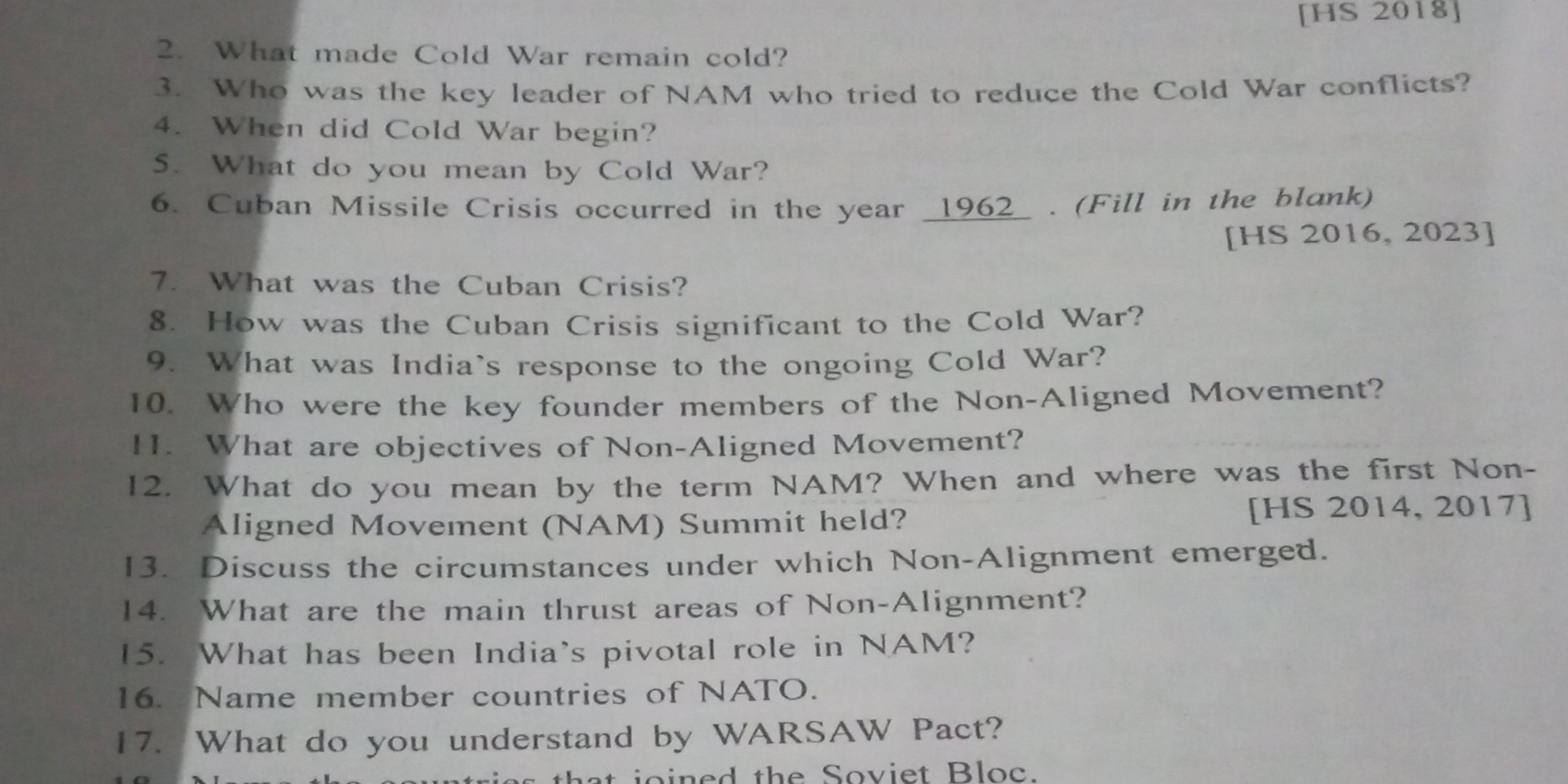What made Cold War remain cold? Who was the key leader of NAM who tried to reduce the Cold War conflicts? When did Cold War begin? What do you mean by Cold War? Cuban Missile Crisi... What made Cold War remain cold? Who was the key leader of NAM who tried to reduce the Cold War conflicts? When did Cold War begin? What do you mean by Cold War? Cuban Missile Crisis occurred in the year 1962. What was the Cuban Crisis? How was the Cuban Crisis significant to the Cold War? What was India's response to the ongoing Cold War? Who were the key founder members of the Non-Aligned Movement? What are objectives of Non-Aligned Movement? What do you mean by the term NAM? When and where was the first Non-Aligned Movement Summit held? Discuss the circumstances under which Non-Alignment emerged. What are the main thrust areas of Non-Alignment? What has been India's pivotal role in NAM? Name member countries of NATO. What do you understand by WARSAW Pact? Name the countries that joined the Soviet Bloc?

Understand the Problem
The question is asking for information regarding the Cold War, its significant events, and the Non-Aligned Movement (NAM), indicating a need to discuss historical contexts and details related to these topics.
Answer
Cold War stayed 'cold' via diplomatic tensions. Nehru was key NAM leader. Cold War began around 1947; Cuban Missile Crisis in 1962 was pivotal. India led NAM promoting peace and neutrality. NAM's key founders include Nehru and Tito. First summit in 1961, Belgrade.
The Cold War remained 'cold' due to the lack of direct military conflict between the USA and the USSR. The key leader of the Non-Aligned Movement (NAM) who worked to reduce Cold War tensions was Jawaharlal Nehru. The Cold War began shortly after World War II, around 1947. The Cold War was characterized by political tension and military rivalry without direct warfare. The Cuban Missile Crisis was a 13-day confrontation in October 1962 over Soviet missiles in Cuba, significant for bringing the superpowers close to nuclear conflict. India's response to the Cold War was through leadership in NAM, advocating non-alignment. Key founders of NAM were Jawaharlal Nehru, Josip Broz Tito, and Gamal Abdel Nasser. Objectives of NAM include promoting peace, decolonization, and self-determination. NAM stands for Non-Aligned Movement, and the first summit was held in Belgrade in 1961. Non-Alignment emerged in the context of decolonization and Cold War tensions. Main thrust areas include peace, security, and development without siding with superpowers. India played a pivotal role by advocating these principles globally. NATO members include the USA, UK, France, Germany, Italy, among others. The Warsaw Pact was a collective defense treaty among the Soviet Bloc, including the USSR, Poland, East Germany, and more.
Answer for screen readers
The Cold War remained 'cold' due to the lack of direct military conflict between the USA and the USSR. The key leader of the Non-Aligned Movement (NAM) who worked to reduce Cold War tensions was Jawaharlal Nehru. The Cold War began shortly after World War II, around 1947. The Cold War was characterized by political tension and military rivalry without direct warfare. The Cuban Missile Crisis was a 13-day confrontation in October 1962 over Soviet missiles in Cuba, significant for bringing the superpowers close to nuclear conflict. India's response to the Cold War was through leadership in NAM, advocating non-alignment. Key founders of NAM were Jawaharlal Nehru, Josip Broz Tito, and Gamal Abdel Nasser. Objectives of NAM include promoting peace, decolonization, and self-determination. NAM stands for Non-Aligned Movement, and the first summit was held in Belgrade in 1961. Non-Alignment emerged in the context of decolonization and Cold War tensions. Main thrust areas include peace, security, and development without siding with superpowers. India played a pivotal role by advocating these principles globally. NATO members include the USA, UK, France, Germany, Italy, among others. The Warsaw Pact was a collective defense treaty among the Soviet Bloc, including the USSR, Poland, East Germany, and more.
More Information
The Cold War era was marked by nuclear arms races and political intrigue but avoided direct warfare between superpowers due to the potential for mutually assured destruction.
Tips
A common mistake is to confuse the Cuban Missile Crisis as a battle or war, rather than a tense political standoff.
Sources
- The Cuban Missile Crisis, October 1962 - Office of the Historian - history.state.gov
- Cold War | Summary, Causes, History, Years, Timeline, & Facts - britannica.com
AI-generated content may contain errors. Please verify critical information